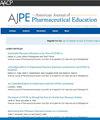Assessment Tools for Evaluating Pharmacy Students’ Knowledge on HIV Prophylaxis: A Scoping Review
IF 3.8
4区 教育学
Q1 EDUCATION, SCIENTIFIC DISCIPLINES
引用次数: 0
Abstract
Objectives
This study aimed to identify and evaluate instruments used to measure pharmacy students’ knowledge of HIV prophylaxis, focusing on both preexposure prophylaxis (PrEP) and postexposure prophylaxis.
Methods
A systematic literature search was conducted using PubMed, Virtual Health Library, Web of Science, Scopus, ScienceDirect, and Embase. Article screening was performed independently by 2 reviewers. Studies assessing pharmacy students’ knowledge of HIV prophylaxis were included.
Findings
Eight studies involving 1,797 students, mostly from the U.S., were identified. All had a cross-sectional design, with only one assessing knowledge retention. Six assessment tools focused on PrEP, one on PEP, and one on both. While confidence in PrEP was evident, significant gaps were found in PEP awareness, prophylaxis access, and prescribing guidelines.
Summary
There is a notable shortage of assessment tools for PEP. Further research is needed to develop validated instruments for measuring knowledge and addressing educational gaps. Longitudinal studies with pre- and post-tests are crucial to evaluate educational interventions and enhance pharmacy students’ preparedness for HIV prophylaxis.
评估药学学生艾滋病预防知识的评估工具:范围综述。
目的:本研究旨在确定和评估用于测量药学学生HIV预防知识的工具,重点关注暴露前预防(PrEP)和暴露后预防(PEP)。了解这些教育工具对于提高健康促进、预防、诊断、治疗和管理方面的知识至关重要。方法:系统检索PubMed、Virtual Health Library、Web of Science、Scopus、Science Direct、Embase等文献。文章筛选由两位审稿人独立完成。包括评估药学专业学生艾滋病预防知识的研究。提取数据并将其组织为两类:研究特征(作者、年份、国家、目标、设计、样本量、持续时间和结果)和工具特征(作者、年份、国家、工具名称、目标、描述、评估类型、评估模式、验证过程和实验阶段)。结果:确定了八项研究,其中一项来自马来西亚,七项来自美国,涉及1797名学生。所有的研究都采用了横断面设计,只有一项研究通过干预来评估知识保留。确定了八种评估工具:六种侧重于PrEP,一种侧重于PEP,一种侧重于两者。一些研究表明,人们对PrEP有相当的了解和信心,但在PEP意识、获得预防和熟悉处方指南方面存在重大差距。结论:PEP的评估工具明显缺乏。需要进一步的研究来开发有效的工具来衡量知识和解决教育差距。前后测试的纵向研究对于评估教育干预措施和加强药学学生对艾滋病毒预防的准备至关重要。
本文章由计算机程序翻译,如有差异,请以英文原文为准。
求助全文
约1分钟内获得全文
求助全文
来源期刊
CiteScore
4.30
自引率
15.20%
发文量
114
期刊介绍:
The Journal accepts unsolicited manuscripts that have not been published and are not under consideration for publication elsewhere. The Journal only considers material related to pharmaceutical education for publication. Authors must prepare manuscripts to conform to the Journal style (Author Instructions). All manuscripts are subject to peer review and approval by the editor prior to acceptance for publication. Reviewers are assigned by the editor with the advice of the editorial board as needed. Manuscripts are submitted and processed online (Submit a Manuscript) using Editorial Manager, an online manuscript tracking system that facilitates communication between the editorial office, editor, associate editors, reviewers, and authors.
After a manuscript is accepted, it is scheduled for publication in an upcoming issue of the Journal. All manuscripts are formatted and copyedited, and returned to the author for review and approval of the changes. Approximately 2 weeks prior to publication, the author receives an electronic proof of the article for final review and approval. Authors are not assessed page charges for publication.

 求助内容:
求助内容: 应助结果提醒方式:
应助结果提醒方式:


